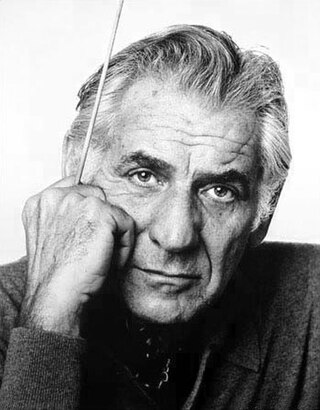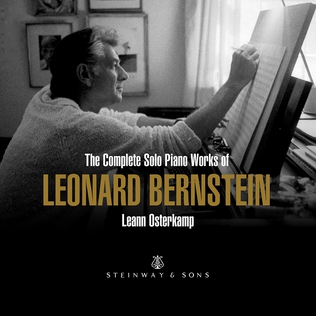| Anniversaries | |
|---|---|
| Piano music by Leonard Bernstein | |
 The composer in the 1950s | |
| Dedication |
|
| Published | 1948 |
| Movements | four |
Four Anniversaries is a composition for piano written in 1948 by the American composer Leonard Bernstein.
| Anniversaries | |
|---|---|
| Piano music by Leonard Bernstein | |
 The composer in the 1950s | |
| Dedication |
|
| Published | 1948 |
| Movements | four |
Four Anniversaries is a composition for piano written in 1948 by the American composer Leonard Bernstein.
Four Anniversaries consists of four movements, each written for a different person in Bernstein’s life. Leonard Bernstein composed four works using the same concept: Seven Anniversaries (1943), Four Anniversaries (1948), Five Anniversaries (1949–1951), and Thirteen Anniversaries (completed 1988). Each movement celebrates the birthday of a different individual, such as Serge Koussevitzky, Paul Bowles, William Schuman, Stephen Sondheim, and Aaron Copland. The Four Anniversaries are dedicated to Felicia Montealegre, Johnny Mehegan, David Diamond, and Helen Coates.
Critic Herbert Livingston described Four Anniversaries:
The first written with restraint and cultivated lyricism, is serene and song-like. There follows a short waspish scherzo, interesting principally for the rhythmic surprises; a slow elegiac piece freely contrapuntal in structure: and a vigorous finale, also predominantly contrapuntal, involving sudden extreme dynamic changes. [1]
It was first performed by Eunice Podis on October 1, 1948 in Cleveland, Ohio. [2] [3]
The four movements complement each other in that while they remain unique and representative of the unique person they were written for. The piece takes its form from the baroque sonata da chiesa form by alternating the movements from slow-fast-slow-fast. There are common themes and a sense of tonality that help to bring the work together. Donald Truesdell quotes James Tocco, pianist, who gets to the heart of the piece:
Lenny may disagree with me but one finds much more about him in the Anniversaries than the people to whom they are dedicated. I sense that Lenny may have been attracted to certain characteristics of a personality that in some way reflected something in himself-aspects of his own personality that he wished to develop. [5]
Leonard Bernstein composed Four Anniversaries for the Piano to commemorate the birthdays of four important people in his life and the result is four individual movements that form one coherent piece.

Leonard Bernstein was an American conductor, composer, pianist, music educator, author, and humanitarian. Considered to be one of the most important conductors of his time, he was the first American-born conductor to receive international acclaim. Bernstein was "one of the most prodigiously talented and successful musicians in American history" according to music critic Donal Henahan. Bernstein's honors and accolades include seven Emmy Awards, two Tony Awards, and 16 Grammy Awards as well as an Academy Award nomination. He received the Kennedy Center Honor in 1981.
Robert Wilfred Levick Simpson was an English composer, as well as a long-serving BBC producer and broadcaster.

The Symphony No. 4 in E minor, Op. 98 by Johannes Brahms is the last of his symphonies. Brahms began working on the piece in Mürzzuschlag, then in the Austro-Hungarian Empire, in 1884, just a year after completing his Symphony No. 3. Brahms conducted the Court Orchestra in Meiningen, Germany, for the work's premiere on 25 October 1885.

Music for Strings, Percussion and Celesta, Sz. 106, BB 114 is one of the best-known compositions by the Hungarian composer Béla Bartók. Commissioned by Paul Sacher to celebrate the tenth anniversary of the chamber orchestra Basler Kammerorchester, the score is dated September 7, 1936.

The Turangalîla-Symphonie is the only symphony by Olivier Messiaen (1908–1992). It was written for an orchestra of large forces from 1946 to 1948 on a commission by Serge Koussevitzky in his wife's memory for the Boston Symphony Orchestra. Along with the Quatuor pour la fin du temps, the symphony is one of the composer's most notable works.

Ludwig van Beethoven's Piano Sonata No. 3 in C major, Op. 2, No. 3, was written in 1795 and dedicated to Joseph Haydn. It was published simultaneously with his first and second sonatas in 1796.
Symphony No. 3 was Aaron Copland's final symphony. It was written between 1944 and 1946, and its first performance took place on October 18, 1946 with the Boston Symphony Orchestra performing under Serge Koussevitzky. If the early Dance Symphony is included in the count, it is actually Copland's fourth symphony.
The String Quartet No. 2 is a string quartet in D major written by Alexander Borodin in 1881. It was dedicated to his wife Ekaterina Protopova. Some scholars, such as Borodin's biographer Serge Dianin, suggest that the quartet was a 20th anniversary gift and that it has a program evoking the couple's first meeting in Heidelberg. Of its four movements, the third movement "Notturno" is the most famous.

Symphony No. 3 "Kaddish" is a programmatic choral symphony by Leonard Bernstein, published in 1963. It is a dramatic work written for a large orchestra, a full choir, a boys' choir, a soprano soloist and a narrator. "Kaddish" refers to the Jewish prayer that is chanted at every synagogue service for the dead but never mentions "death."

Felicia Montealegre Bernstein was an American actress born in Costa Rica.
The Piano Sonata in A minor D. 845 (Op.42) by Franz Schubert is a sonata for solo piano. Composed in May 1825 and entitled Premiere Grande Sonata, it is the first of three sonatas published during the composer's lifetime, the others being D.850 and D.894. Conceived as a set, these works were composed during what was reportedly a period of relatively good health and spirits for Schubert, and are praised for their quality and ambition. This first sonata in particular marks a significant step toward the composer’s mature piano sonata style; the format and several characteristic stylistic elements continue through the last.

Johannes Brahms composed his Piano Trio No. 2 in C Major, Op. 87, between 1880 and 1882. It is scored for piano, violin and cello. He wrote this piece at the age of 49.

Thirteen Anniversaries is a composition for solo piano by Leonard Bernstein, published in 1988, commemorating 13 people who played an important role in his life.

Five Anniversaries is a set of short pieces for piano by American composer Leonard Bernstein and the third installment in the series of Anniversaries for piano. It was composed between 1949 and 1951. It is known for presenting some of the musical ideas that were later developed in other works.
Music for the Dance No. 2 is a composition for piano by American composer Leonard Bernstein. It was finished in 1938.
The Piano Sonata, originally entitled Sonata for the Piano, is the only piano sonata by American composer Leonard Bernstein. An early work by the composer, it was finished in 1938.
Four Sabras is a short composition for solo piano by American composer Leonard Bernstein. Each Sabra refers to vignettes or portraits of different fictitious Israeli children.

Bridal Suite is a suite for two pianists by American composer Leonard Bernstein. Composed in 1960, it was written for Phyllis Newman's wedding with Adolph Green.
Scherzo in F-sharp minor is a piece for orchestra written by Dmitri Shostakovich (1906–1975). Shostakovich was a Russian composer and pianist during the Soviet era. It was most likely written in 1921 or 1922 while Shostakovich was studying at the Petrograd Conservatory under Maximilian Steinberg. The composition is one of the composer's earliest surviving works. Originally written as a single movement of a piano sonata, the Scherzo was later orchestrated with assistance from Steinberg and became an orchestral work in its own right.

Divertimento, or Divertimento for Orchestra, is a suite of eight orchestral bagatelles by American composer Leonard Bernstein. Completed in 1980 and written to celebrate the centenary of the Boston Symphony Orchestra, it is well-known for featuring the notes B and C in most of its melodic material.